It may have started out as just another post-Ridge Racer driving game with a unique focus on beautifully destructive car crashes, but over the years, the Burnout series has really carved out its own spot in the racing genre. Last year's Burnout 3: Takedown was when the series truly came into its own by achieving a near-perfect balance between high-speed racing and nefarious racing tactics designed to put the other racers out of commission. With a name like Burnout Revenge, you might expect the latest game in the series to be a little rougher, a little meaner. And you'd be right. While it isn't a total reinvention, Burnout Revenge makes significant alterations to the Burnout formula that essentially render every other game in the series obsolete.
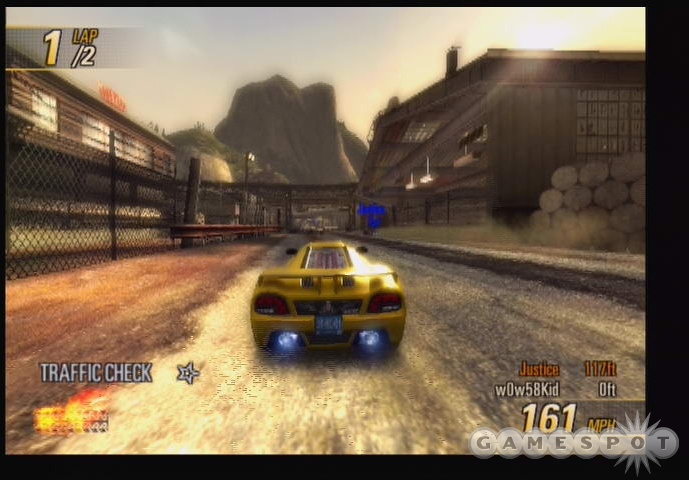
The biggest changes in Burnout Revenge come in its track design and in the ability to slam into some nonracing traffic and plow right through it. Wrecking into innocent bystanders in automobiles is known as traffic checking, and it's limited to small and medium-sized cars that are stopped or traveling in the same direction as your vehicle. These cars, once hit by a racer, essentially become weapons. If you slam them just right, you can send them flying into the other lane, ideally slamming into another racer and taking him down immediately. But checked traffic will also fly behind you after being rear-ended, letting you create tricky flying obstacles for other racers to avoid. Having to keep track of which traffic you can and can't hit adds an interesting layer of complexity to the game, though the sometimes comical physics displayed by checked traffic--which flies around like you're wrecking into an aluminum can--looks a little weird. The whole concept also ties in to the new traffic attack event, which gives you money for each car you smash and ties its medals to specific dollar amounts.
The design of Burnout Revenge's tracks make an even bigger impact on the way the game feels, and they give you a lot to think about. Each of the game's tracks is now packed full of alternate routes, some of which serve as shortcuts. Some of them really just serve as ramps, letting you set up for tough but supremely satisfying vertical takedowns. Crashing down from above onto an opponent is one of the more thrilling moments the game has to offer. The increased complexity of the game's tracks also has an impact on your boost meter. Most of the routes don't have any traffic on them and don't count as oncoming lanes, meaning the only two ways to earn boost while on an alternate route are to slam into other racers or to drift. Since neither are guarantees, it's easy for some alternate routes to turn into longer paths than the main track. But for events like online road rage, where you might be trying to avoid detection, these routes make it much easier to hide. In the end, all roads lead back to the main path one way or another, so you're never separated from the action for too long.
All the game's modes and events are rolled up into a single-player world tour mode. Unlike last year's game, Revenge's world tour doesn't really take place on a world map. Instead, events are broken into 11 different ranks. Earning gold medals is a major goal, but you'll also have to earn stars to rise through the ranks. Stars are earned in every different type of event, and outside of crash mode, you get them from driving as aggressively as possible. Drifting, hitting other cars, taking out your rivals, driving in the wrong lane, and catching air are just some of the things that impact your star meter. Your task in each race is to finish with an "awesome" rating, which translates to four stars. Winning the event with a gold medal adds a star to your rating, taking you up to "perfect." Conversely, finishing with bronze subtracts a star. These stars are tallied up after each event, and they go into your rank. When you hit a certain star count, you go up to the next rank, giving you access to another set of races.
The world tour front end is more complicated than it needs to be. It starts out with one section for each rank. Each rank has a list of locations, and each location has a list of races. Sounds straightforward, right? But sometimes you'll unlock races in previous ranks while working up in a higher one, especially if you're focusing on crash events over race events, or vice versa. So you won't consistently move up to the higher ranks, as you'll constantly have to dig through the other ranks in search of events you haven't completed yet. Additionally, the game seems to run out of new tracks and crash environments about halfway through. You'll race every single type of race on every possible track, both forward and backward. After awhile, it starts to get a little repetitive, but with each new rank, you do uncover a few new twists.
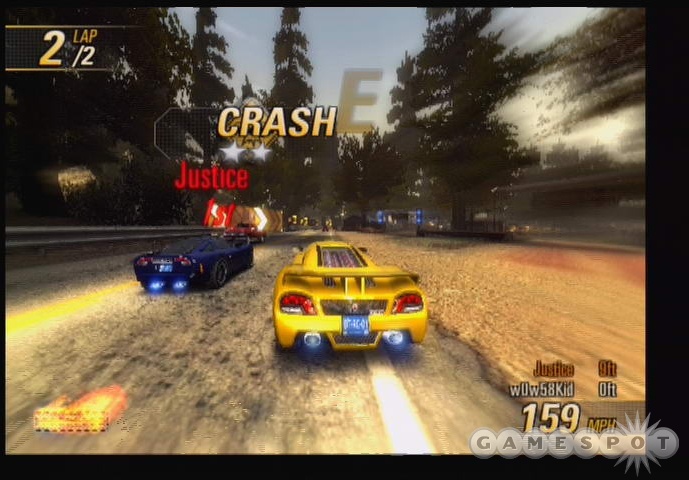
Your choice of cars has also been made a little tougher. In Burnout 3, everything was spelled out for you right away. Each race fit into a class, and the most recent car you had in that class was usually the right one to use. Now, each car is rated in its top boost speed, its weight class (which tells you how likely it is to get pushed around the road by other cars, as well as how it handles around corners), and its crashbreaker force. When you unlock a new car, there's no guarantee it'll be your new best vehicle, so selecting a vehicle takes a little more thought than it probably needs to. More often than not, though, the right-most car on your list is the one you'll want to use for races. Speaking of cars, you can earn a couple of extra cars right off the bat by having saves for Burnout 3 and Madden NFL 06 on the same card or hard drive as your Burnout Revenge save. If you plan to get these cars, make sure you get the saves first, as adding the saves later won't give you the cars, and apparently they aren't unlockable by any other means.
World tour mode lets you work through 169 different events on your quest for 100 percent completion. Along the way, you'll see all the game's various race types. For starters, there's your basic race, which asks you to finish ahead of five other vehicles. Eliminator puts a 30-second timer on the screen. The last place racer is cut from the race every 30 seconds until only the winner remains. Road rage puts a never-ending series of opponent cars on the track and asks you to force as many of them to crash as possible. Medals are tied to specific numbers of crashes, and you'll also earn time bonuses after every few takedowns. Burning laps and preview races are solo races against the clock that often give you access to cars much faster than the ones you're currently racing with. When you get into the later races, you'll get into crashbreaker variations of some of these events. This means that whenever you crash, you can tap a button to cause your car to explode, often with enough force to take out any other racers that might be nearby. Catching other racers in a crashbreaker is a good way to refill or extend your boost bar, and the other cars tend to move away quickly enough after a takedown to prevent an instant crashbreaker from automatically getting revenge, which helps keep the system more balanced.
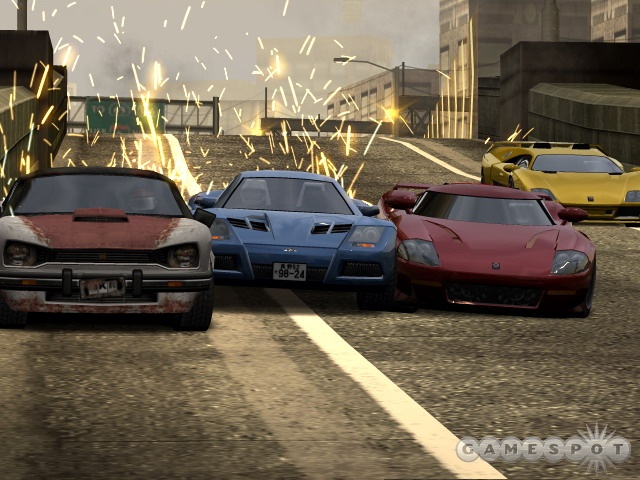
In all the single-player racers, you'll go up against artificially intelligent racers that are governed by a very rubber-banded system that's intended to keep races close. This is usually the part that forces racing game fans to turn away in disgust, but considering that the whole crux of Burnout Revenge is slamming into the other racers and fighting for position, the game absolutely needs this sort of AI system to work at all. As a result, you can expect to always have racers around you, creeping up on your back door when you're in the lead. In later races, the other cars get mean and really start trying to take you down. But on average, they're never too much to deal with, and overall, the game feels like it's quite a bit easier than Burnout 3 was. If you're the sort of person that broke through to 100 percent completion last time around, you might find the game to be a little too easy, in fact.
Aside from the races, the other major portion of Burnout is crash mode. While you're still driving a car in this segment of the game, crash mode is more of a puzzle game than a racing one. You're dropped into an environment filled with cars going about their artificially intelligent business. It's your job to find a way to cause the most dramatic car pileup that you can. How, when, and where you crash is the key. For example, it's always best to block as many lanes as possible to ensure a larger, multidirectional crash. The crash mode in Burnout 3 was filled with onscreen power-ups and bonuses that essentially served as big bull's-eyes for you to aim at. This made them pretty easy. The crash mode in Revenge has been changed quite a bit. All the power-ups are gone, but you can pull off multiple crashbreakers in one run if you drag enough cars into the fray. Also, explosions and rating increases serve as your score multipliers. Some of the game's crash junctions can be real head-scratchers, as the combination of where to wreck and which vehicle to drive can get a little tricky later in the game. The early events, however, aren't terribly tough, and overall, it doesn't get much more difficult than Burnout 3's crash mode was. On top of all that, retrying a crash event seems to load faster than it did in Burnout 3, especially on the Xbox.
Both versions of the game allow for split-screen racing, including crash battle, where two racers play crash mode at the same time on the same track. But really, if you're going to play Burnout Revenge with more than one person, you want to play it online. Here, up to six players can compete in most of the single-player race types. Road rage becomes a team event online, with one team trying to finish a race while the other tries to take down the racing team. Crash battle and other variants of crash are also available online, but without the overview of the junction before you race, you'll have to go out of your way to memorize each pattern from its name alone. The racing and road rage modes are quite exciting online, and the addition of traffic checking really makes a difference. However, one thing you'll notice about checked traffic is that it tends to vanish off the screen after a few seconds. That doesn't seem to happen offline.
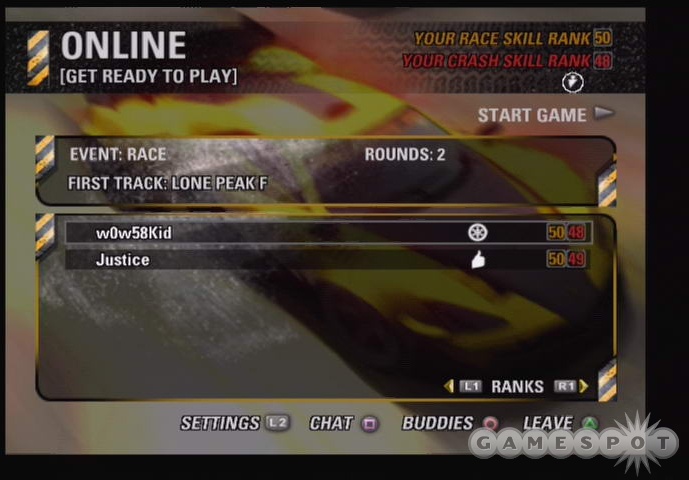
Also, the game uses an entirely new rating and rank system online that gives you much more in-depth scoreboards. It also sort of locks away a lot of your car and track options right out of the gate. Online, you progress through the same ranking system that you do offline, but you do it much more quickly. At the start, you'll only be able to host games in your low rank (or in the unrestricted rank, if you really want to open yourself up to high-ranked players coming in with better cars), and you'll be limited to a handful of tracks. As you race, you earn points that go into your rank. With dedication, you can take your race rank from a lowly rank 1 up to 6 in five or six hours. The catch is that you're also sort of re-unlocking the cars that you already unlocked offline, which is weird and pretty unrewarding. Still, the ranks come pretty quickly online, so you aren't kept away from your favorite vehicles for very long.
The player-matching in Burnout Revenge takes a page from the Halo 2 playbook. You're given separate ratings for crash and races, and that rating increases as you play. That rating also dictates what sort of players you'll be matched up with when you go looking for a game. The party system introduced in Halo 2 is also used here, so you can form a party and then go out looking for challengers. These are cool additions that make much more sense than the nearly useless text-only lobbies in Burnout 3.
It's been said before, but it's worth repeating: One of the most important things a racing game can do is properly convey what it feels like to be driving at ridiculously breakneck speeds. On the graphical side, it's several parts frame rate combined with a dash of great blur effects, perhaps with a little camera shaking thrown in for good measure. As simple as the formula sounds, most racing games fail to get it right. Burnout Revenge is the new game to beat when it comes to delivering that feeling of flying around corners and through alleys at speeds north of 200 miles per hour. But this game isn't all speed with no substance. If you manage to stop for a second, take a look at the car models. They're not only incredibly smooth and shiny-looking, but also they're actually extremely cool car designs. Burnout might not be able to get licensed cars in the game, but with modern and occasionally flashy car designs like this, you almost wish someone would put them into actual production. Similarly, the environments look fantastic, with terrific textures and great effects. Crashes and collisions have, obviously, been given special attention. Cars blast apart in even more dynamic ways this year, and explosions are truly terrifying. Rounding out the package are some new camera angles that help make crashes look as dramatic as possible.
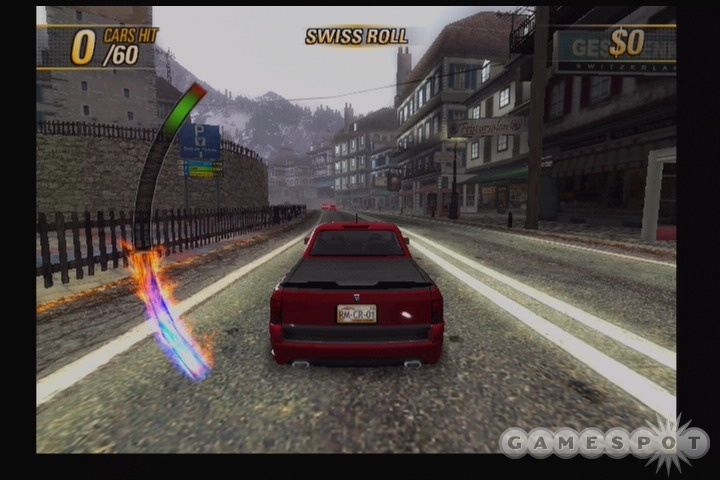
Both the PlayStation 2 and Xbox versions look fantastic, but if you're choosing between the two, the Xbox version is the one to get. Visually, the game's crisper on the Xbox. It's also a good reason to get a widescreen HDTV setup for either platform, as the increased clarity makes it easier to pick out traffic before it gets close. In our anecdotal testing, we wrecked a lot more frequently on a standard resolution 4:3 set. Outside of graphics, the Xbox version has a much cleaner online experience, free from the hassle of creating or maintaining an EA-specific login. Plus, the analog triggers on the Xbox controller give you better control over your vehicle. It's still an amazing PlayStation 2 game, of course, but given the choice, you're better off with the Xbox version.
The graphics are certainly a big part of what gives the game its feel, but you simply can't discount the importance of sound when it comes to that whole "sense of speed" thing. You'll especially notice it with a surround-sound configuration, but even with your TV speakers, Burnout Revenge has completely mind-blowing sound effects. As you race around the course, you're constantly hearing the scenery, traffic, and other objects whip right past you with a distinct whoosh of air. The sound of metal on metal whenever you collide with another object adds a lot of outstanding scrapes and bumps. And when you kick in your boost, it practically sounds like a jet taking off in your living room. Game sound effects really don't get much better than this.
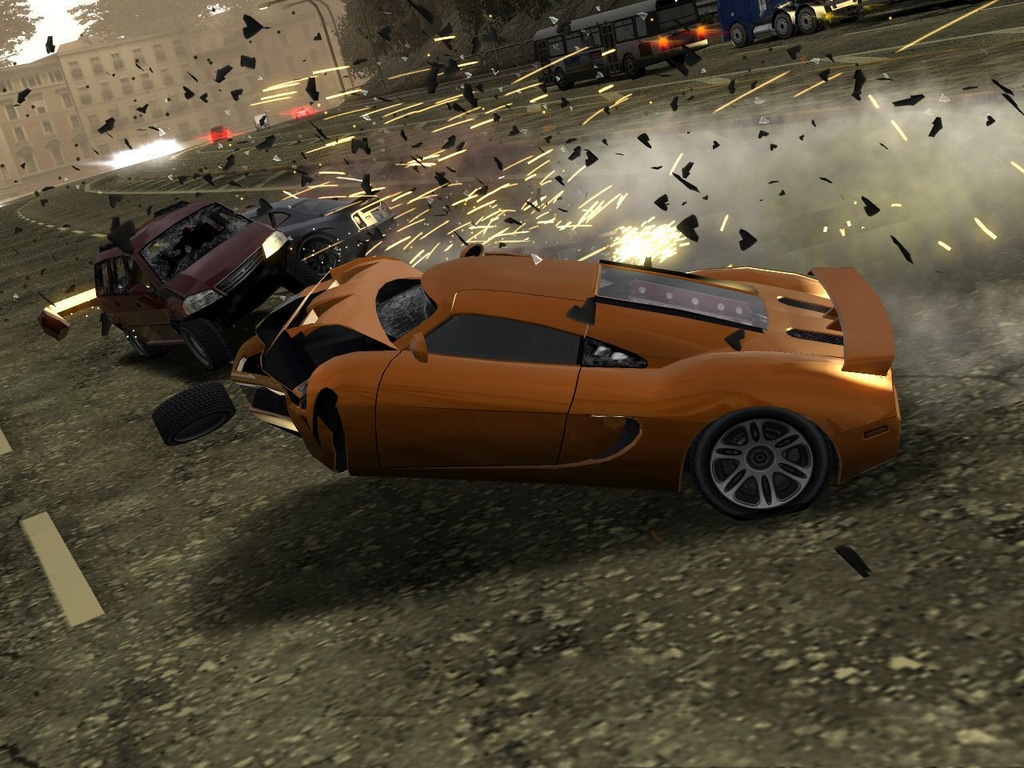
The music side of Burnout 3 was problematic. The overtly pop-punk soundtrack simply didn't mesh with the action at all, and the game contained a lame, upbeat radio DJ that would chime in with annoying chatter midrace. Burnout Revenge fixes all that. That's not to say the soundtrack is completely free from pop-punk, but overall, the soundtrack is much more aggressive and varied, which lends itself well to the game's darker theme. Additionally, there's no DJ during races. A female voice accompanies the game's training videos, which can be skipped this time around if you already know what you're doing. Car-collection sequences can also be skipped now, in case you're in a hurry to get back to the action. Also, the Xbox version supports custom soundtracks.
Burnout Revenge might not be the revolution that Burnout 3 was, but in the end, it changes more than enough to make it feel like a very different game. It's a technical marvel, but more importantly than that, it's one of the most exciting racing games ever made. Unless you don't have the reflexes to handle it, Burnout Revenge is a must-own game, especially for fans of online competition.